You Don’t Have to See Versailles Like the Peasants
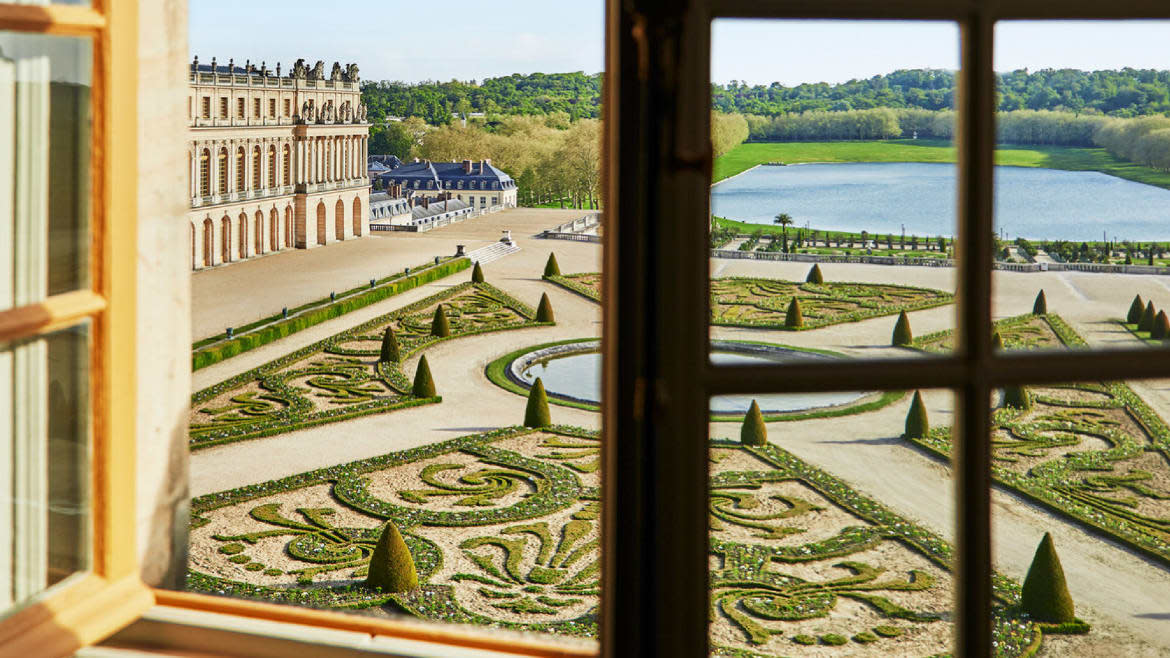
VERSAILLES—Dawn broke over the Château de Versailles about a half-hour ago, and I’m straddling a gorgeous male from Portugal and thinking of Marie Antoinette.
The male in question is a tall white horse named Spartacus who is showing remarkable patience for my rusty riding skills, save for the two times he abruptly stopped to munch on a damp patch of grass—which sent me pitching forward in the saddle.
It isn’t only the fact that I’m clip-clopping through her old stomping grounds that has me thinking of France’s last queen. It was Marie Antoinette, after all, who donned breeches and chucked the petticoats and skirts that women of her era typically wore to cover them. She ditched the demure side-saddle pose too, preferring to sit astride her steed masculine-style (califourchon in French).
The Swiss artist Louis-Auguste Brun depicted the young monarch in this exact position in his 1783 oil painting, Portrait de Marie-Antoinette à la chasse. Indeed, rather than the over-the-top, meringue-like gowns the queen is famed for, she’s sporting masculine hunting attire comprising green breeches and a mustard-yellow jacket. According to the palace, so transgressive was the image at the time, that when the Gallery of French Fashions and Costume used it on an engraved plate, the breeches were replaced with a skirt.
Not only was Marie Antoinette’s cross-dressing considered scandalous, but her position astride the horse was also believed to be a health hazard that could render a woman infertile. It was for that very reason that Maria Theresa of Austria pleaded with her daughter to give up the sport.
“Riding spoils the complexion, and in the end your waistline will suffer from it and begin to show more noticeably,” her mother admonished the teenaged dauphine. “Furthermore, if you are riding like a man, dressed as a man, as I suspect you are, I have to tell you that I find it dangerous as well as bad for bearing children—and that is what you have been called upon to do; that will be the measure of your success."
Although Marie Theresa wielded a powerful influence over her life, her daughter wasn’t having it.
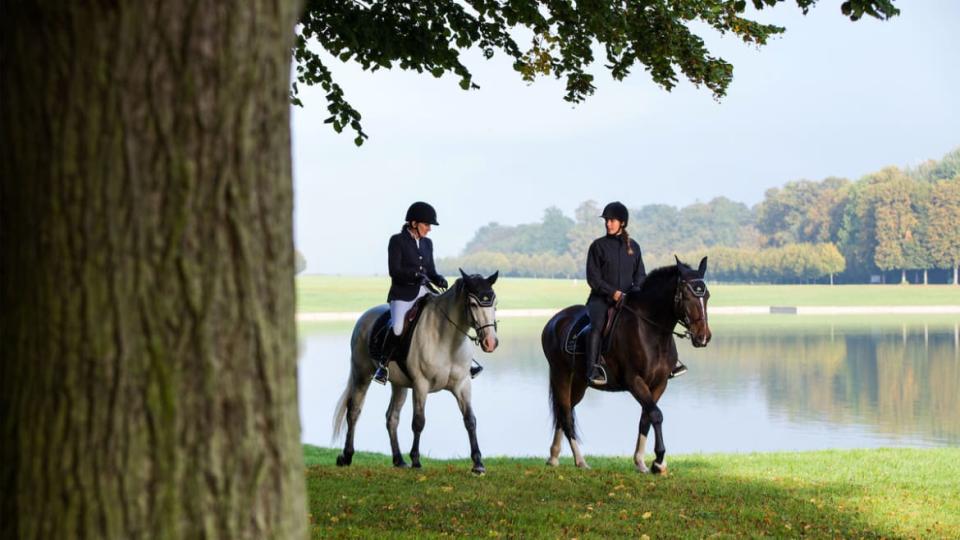
“The King and Monsieur le Dauphin take pleasure in seeing me on horseback,” she responded, referring, of course, to Louis XV and his grandson Louis XVI, who she would go on to marry. “They have been enchanted to see me in the uniform of the hunt.”
Her mother relented and Marie Antoinette continued the ride.
Horses and riding played a prominent role at the palace even before this mother-daughter tiff and were seen as an important component of royal identity. Indeed, to celebrate the birth of his son in 1662, Louis XIV put on a grand equine show before some 10,000 spectators on the grounds of the Tuileries palace. And Antoine Coysevox, who was the most sought-after sculptor after during the waning days of the Sun King’s reign, designed an imposing bronze equestrian statue of Louis XIV in the late 1600s. The original was melted to make cannon fodder, but a smaller scale copy and two original side reliefs are on display at the Museum of Fine Arts in Rennes. Less lauded was the Italian master sculptor Bernini’s marble rendition of Louis XIV on horseback, which the latter hated so much that he had it banished to a corner of the château’s gardens.
According to palace officials, “In political terms, the King had to distinguish himself through his excellent horsemanship, which was a symbol of his ability to govern well.”
Indeed, the palace’s Great and Small Stables were constructed during Louis XVI’s reign and housed the royal family’s horses, as well as steeds used in hunts and at the palace’s riding school. Some 400 horses resided in the stables in 1680, and their numbers had swelled to more than 2,200 by the eve of the French Revolution.
Centuries later, the country’s enthusiasm for horses and for riding hasn’t waned.
According to the Fédération Équestre Internationale (FEI), some 2 million French people ride horses “regularly or occasionally.” On its website, the FEI reports that there are 5,000 equestrian centers in the country, however, the figure is listed as over 9,000 in French media reports and in statistics from the French Ministry of Agriculture.
The prestigious stud farms, Haras National de Pompadour in Corrèze and Haras National du Pin in southern Normandy, were set up during Louis XIV’s reign and host numerous equestrian events every year. There’s also the annual Longines FEI Jumping Nations Cup in western France, as well as the Generali French Open, which is considered the largest equestrian event in the world.
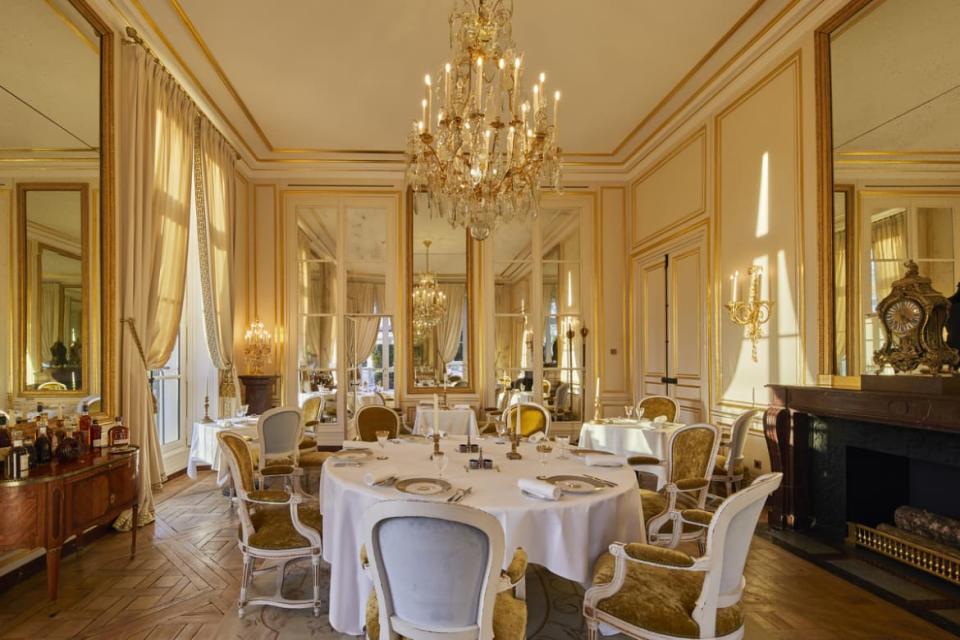
France’s love of horses also extends to the art and fashion worlds. Iconic luxury brands like Hermès and Longchamp have ties to the country’s horse culture that extend beyond their equine-centric logos. The latter’s galloping horse, for instance, drew inspiration from the Longchamp Racecourse, which opened in Paris in 1857 and continues to operate today.
And while the former’s vivid silk scarves and Birkin bag have been synonymous with the French fashion house for decades, its origins are in high-end saddlery, and I was surprised to learn that the company still crafts bespoke saddles at its Paris workshop.
In 2002, Hermès released an ice-blue scarf designed by Hubert de Watrigant honoring the Musée Vivant du Cheval (the Living Museum of the Horse). Located in the Château de Chantilly’s Great Stables, the palatial museum is dedicated to all things equine and features diverse exhibits—everything from bits and stirrups to rocking horses to decorative arts—as well as live equestrian shows. And who in France can forget the time that Emmanuel Macron tried to woo Chinese President Xi Jinping during a 2018 state visit by gifting him a horse from the presidential cavalry corps?
“Why French cinema loves horses,” read the headline of an article that ran on the French news outlet BFMTV in late-December, regarding two recent horse-focused flicks. Hint, it’s ingrained in the culture.
There are numerous places to go horseback riding in France, but none marry centuries of thrilling history with an ongoing love of equestrianism quite like the country’s onetime royal residence. In addition to holding thrice-weekly choreographed equestrian shows at the Great Stables for the past 20 years, the Palace of Versailles will also play host to the 2024 Olympics’ equestrian events, during which a temporary outdoor arena will be set up on the Etoile Royale esplanade. The jumping and dressage competitions will be held at the arena, while the individual and team cross-country section will be held alongside the palace’s iconic Grand Canal.
There are a few tour companies that offer guided horseback rides on the palace grounds, including Airelles Château de Versailles, Le Grand Contrôle, the recently opened luxury hotel that sits right next to the Orangerie gardens. And even though I hadn’t ridden regularly since college, which was, um, a few years back, the opportunity to not only ride like French royalty, but to also live like a queen for a day (even if it meant an early wake-up call), was too tempting to pass up.
Comprising three 17th-century buildings, the hotel occupies the former apartments of Louis XVI’s finance minister, Jacques Necker. Save for the odd event organized by the French army, the space had remained unused for decades before it was transformed into upscale lodging that merges high-level luxury with the sort of ancien regime-style theatrics that’s a fitting tribute to drama and excesses that the palace was known for in its heyday.
The Daily Beast previously covered the hotel’s opening, so although I felt like I’d been briefed, the sight of a young man with a flop of indigo hair posing on the entry hall staircase in a pale pink gown fit for France’s last queen was nonetheless an unexpected and fantastic prelude to my stay. Apparently, the stylish gentleman in question was engaging in a photoshoot—another add-on experience offered by the hotel. The outfits, he told me later, were designed by professional costume-makers and used in French period dramas.
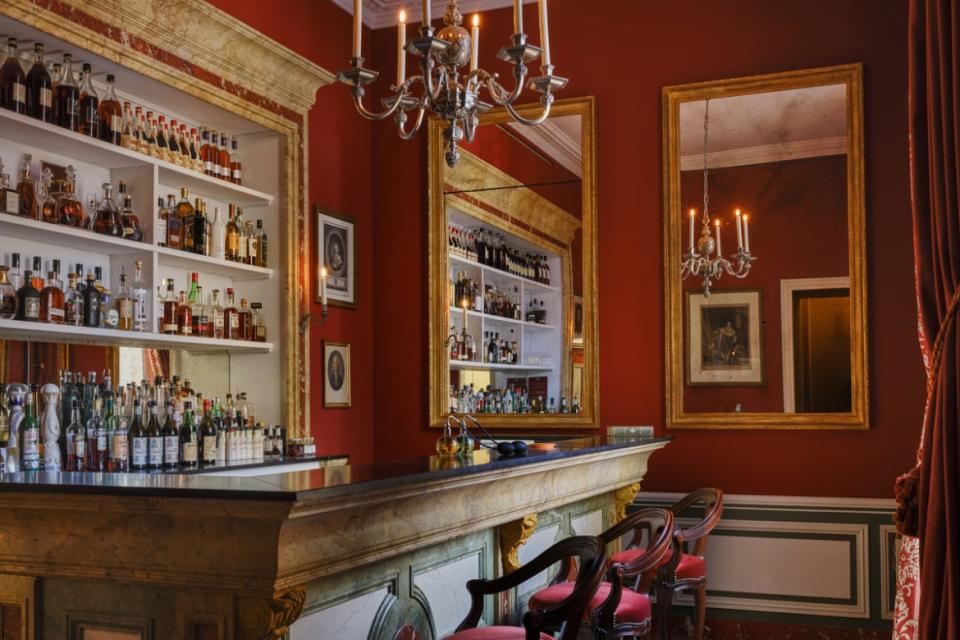
Speaking of period dramas, I couldn’t help but feel like I had tumbled into one over a lengthy five-course meal that was served in the hotel’s Michelin-star restaurant. The Alain Ducasse-designed menu featured dishes like roasted venison and scallops with celery and citrus—modeled after what members of the royal court would have feasted on a few centuries back—and servers clad in period garb enthusiastically announced each course by thumping a wooden staff on the floor in a dining room illuminated entirely by candlelight.
I wanted to be in top form for my ride the next day, so after the meal I retreated to the Loménie de Brienne Suite, with its dusty rose Toile de Jouy covered walls and polished parquet floors, for an earlyish bedtime.
In a desire to make my equestrian adventure as authentically regal as possible, I opted, albeit with some wariness, for the “royal wakeup.” Sure enough, at 6:30 a.m., I was awakened by the sound of a strange man scratching at my door. Was he using a staff? A brittle antique fan? I was curious but too tired to investigate. After I mumbled a groggy, “oui?” the sound of Baroque music filled the suite—was it coming from a portable speaker? His phone?—and with it a soft whiff of floral perfume.
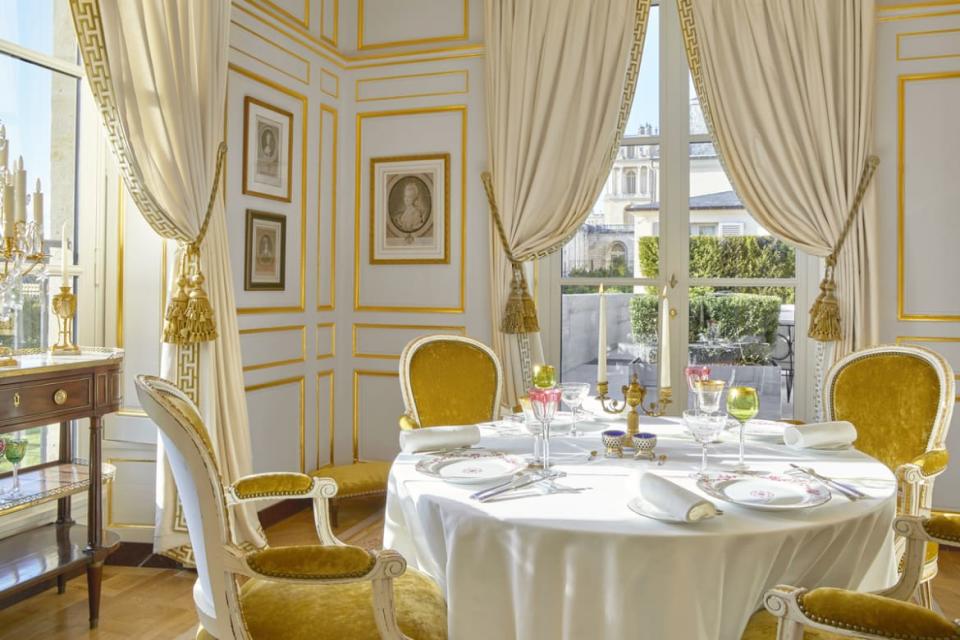
After opening the curtains and presenting me with a small crystal glass of warm almond milk flavored with peach blossom (apparently, a common morning concoction for Versailles courtiers) he drew a bath in the clawfoot tub, wished me a “belle matinée,” and departed along with the fading trill of harpsichords. The water was a touch too hot, but the roses floating in the scented water made up for it and I could have spent a good hour lounging in the tub had I not been pressed for time.
I didn’t have any vintage riding breeches but made do with skinny pants and a puffer jacket. After a quick breakfast of poached eggs and green tea, I dashed out to meet one of the hotel’s drivers who whisked me off to where my mount was waiting.
Émilien, my guide on the two-hour trek, explains that while Spartacus is friendly, he can sense a rider’s unease, which can make him react anxiously. I’m used to horses, but it’s still hard not to be intimidated by both his stature and the fact that I need a step stool for the mount. Soon though, we’re off at a gentle walk, and later, a brisk trot. And aside from the aforementioned sudden snack breaks, Spartacus is gentle and easy to ride. Both Émilien and the horses live in neighboring Rambouillet, where Émilien also offers guided rides through the town’s famed forest, which, fittingly, was one of the French monarchy’s favorite hunting areas.
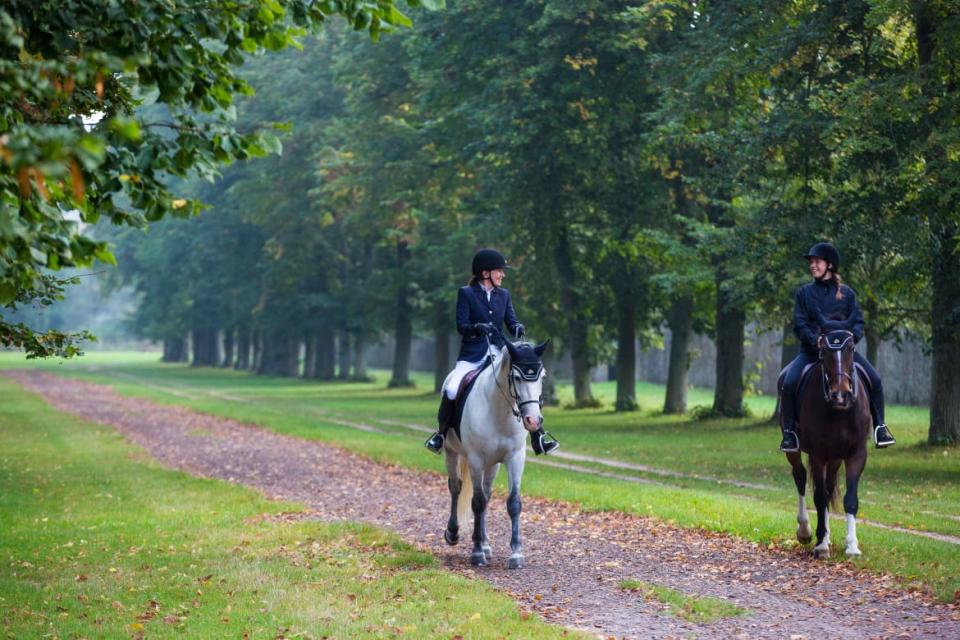
I’m so immersed in the ride that I don’t notice the first hour go by. Winter is moving in, and the palace grounds are strewn with fading leaves that flutter listlessly in the crisp wind. Aside from the odd maintenance vehicle and a couple of joggers, the park is empty. My college-era riding school was at the base of Santa Barbara’s Santa Ynez mountains, and I had always thought that the rugged peaks and verdant foothills would be tough to top scenery-wise. However, the alleys lined with chestnut trees, the peak at the rustic cottages of the Queen’s Hamlet, and the thrilling view of the sprawling château in the early morning light were truly next level.
And while the landscape is superb, it’s the seclusion that makes the experience stand out. As anyone who has visited Versailles can attest, the palace is one of the most tourist-heavy destinations in France and having the grounds virtually to myself was almost surreal. Add to that the sumptuous lodging, the (literal) bath of roses, and the striking steed, and it’s easy to become swept up in a passion for riding à la Marie Antoinette—18th-century breeches not required.
Get the Daily Beast's biggest scoops and scandals delivered right to your inbox. Sign up now.
Stay informed and gain unlimited access to the Daily Beast's unmatched reporting. Subscribe now.

